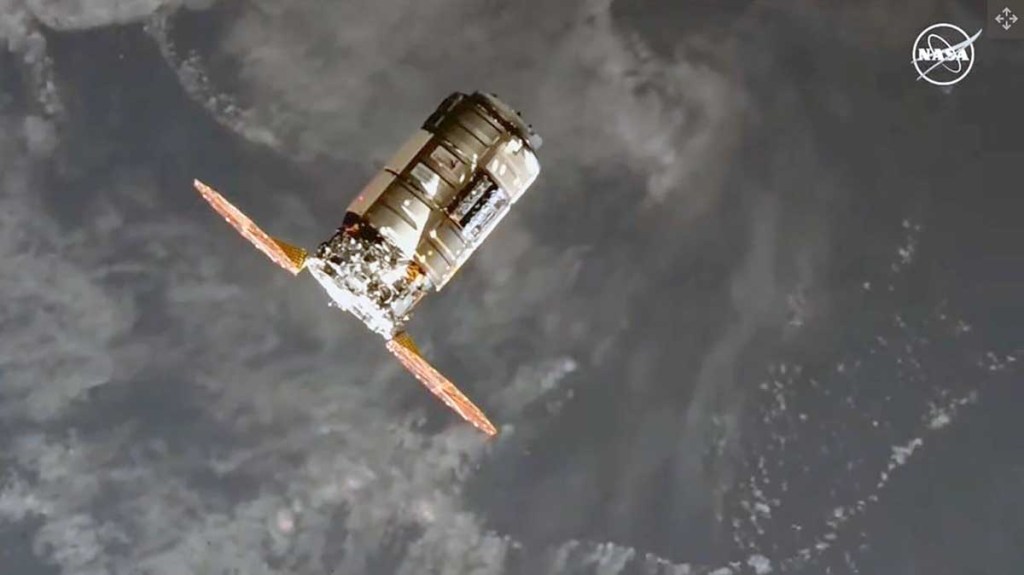OUR SPACE: The swan flies again
Published 9:42 am Tuesday, August 13, 2024

- Northrop Grumman's Cygnus NG-21 Richard 'Dick' Scobee cargo spacecraft approaches the International Space Station's robotic arm on August 6, 2024.
Everybody loves it when the mail truck stops by their house to deliver a much-anticipated package. Imagine you’re stuck inside a tiny house, with no way of going outside or even opening a window, and you have to make do with whatever you have at home. You ran out of fresh food a while ago and have been eating reconstituted meals for a while. And then you get message that a huge package of fresh food and other things is on its way — of course you’ll be excited, with your nose pressed against the window, waiting for the truck. If that sounds too familiar, well, it is — just four short years ago many of us had to live that way to avoid the global scourge of COVID-19. But there’s a handful of people 200 miles straight up living on the International Space Station (ISS) for whom this is still very much reality.
Trending
Enter a cargo freighter, a pressurized but uncrewed spacecraft stuffed to the gills with supplies: fresh water, fruit and vegetables, clothes and fun items, as well as new or replacement equipment, repair parts, tools and stacks upon stacks of science experiments, with the odd cube sat mixed in. The arrival of a cargo craft is always a celebration on the ISS. It could be a Russian Progress ship, a Cargo Dragon or a Cygnus Freighter, either way, it’s an exciting day for the station residents. Some of those cargo craft are disposable, meaning they get stuffed full of trash and obsolete equipment and then sent back down to Earth at an angle that will cause them to burn up in the atmosphere over an uninhabited part of the ocean. Some of them make a tightly controlled re-entry to preserve whatever is on board, and then it gets picked up and hauled to a processing facility where the materials are swiftly routed to their final destination.
Last week a Cygnus freighter launched to the ISS — the 21st to date, which is why the mission is called the Cygnus NG-21. The NG stands for Northrop Grumman, the manufacturer. Cygnus means swan in English, and while this bird regularly travels to space, it never comes back home. Shaped like a large cylinder it has no way to make it back through the atmosphere.
So yes, it’s a big barrel-shaped thing that could fit an average fire truck, with two round solar panels on either side of its rump that unfold like giant fans. This barrel is really smart, though. It is a spacecraft after all, with onboard computers, propulsion and a full electrical system. It can carry freezers and refrigerators for both food and science payloads, ovens for burn experiments, and best of all, it has lots of space for cargo.
Each Cygnus freighter is named after an important space pioneer; NG-21 is named after Richard ‘Dick’ Scobee, the valiant commander of the tragic last mission of the Space Shuttle Challenger. After a scrubbed first launch attempts due to nasty weather NG-21 had a picture-perfect textbook launch from Kennedy Space Center. Within eight minutes the spacecraft was in orbit and on its way to the ISS. Then trouble started – it missed a burn to go into the correct orbit but engineers worked feverishly to add more burns and concluded the spacecraft was still good to go to the ISS. It docked successfully early on Tuesday morning. Big sighs of relief all around!
While the S.S. Richard ‘Dick’ Scobee has a lot of fancy equipment and autonomous functions it cannot dock on the ISS on its own. This feat is accomplished via the robotic CanadArm2 — the multi-jointed miracle grabber aboard the ISS. CanadArm2 slides along the spine of the station on tracks to go where it’s needed. Its “hand,”if you will, is an amazing feature of engineering, and while it was not intended to grab spacecraft, at least not originally, it has done so around 50 times by now. Once the CanadArm2 has grabbed the Cygnus it will gently guide it to an available docking port where the freighter can be berthed and securely connected to the ISS.
Just like with the arrival of a crew-carrying craft there are lengthy procedures that must be followed until the hatches can be safely opened, and then the unloading can begin — it’s like all the holidays where you get gifts rolled into one! And luckily, in microgravity even moving heavy stuff is relatively easy, but you still have to be careful. Stuff may not “weigh” anything in the traditional sense, but it still has all of its mass, and you have to be mindful not to crash it into something.
Trending
Learn more about the humble cargo ship that does so much more than just deliver the goods at https://www.northropgrumman.com/
Beate Czogalla is the professor of Theater Design in the Department of Theatre and Dance at Georgia College & State University. She has had a lifelong interest in space exploration and has been a Solar System Ambassador for the Jet Propulsion Laboratory/ NASA for many years. She can be reached at our_space2@yahoo.com.






